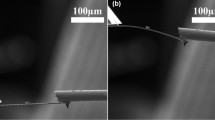Abstract
To study the applicability of the basalt fiber through various experimental works in thermal and chemical environments, glass fiber and carbon fiber were compared and discussed. The tensile strength testing was used to investigate the corrosive resistance of basalt fiber, meanwhile, surface study by scanning electron microscopy and microanalysis with complementary X-ray diffraction analysis (SEM/EDS) was also used to ascertain the durability of basalt fiber. The basalt fiber showed better strength retention than the glass fiber at relatively high temperature. Its tensile strength increased when exposed at 300 °C for several hours, and still maintain about 70% of the initial strength at 400 °C, whereas that of the glass fiber decreased dramatically. The better stability of the basalt fiber was observed in hydrothermal and chemical environment. The tensile strength of the basalt fiber increased by 20% after the immersion in boiling water and remained well in acid solution, when it comes to glass fiber, the tensile strength decreased to some extent. Although the alkali resistance of basalt fiber was poor at the initial stage, it shows better resistance than the glass fiber after long time treatment.
Similar content being viewed by others
References
M Friedrich, A Schulze, G Prosch et al. Investigation of Chemically Treated Basalt and Glass Fibres[J]. Mikrochim. Acta, 2000, 133: 171–174
E Bernardo, E Stoll, A R Boccaccini. Novel Basalt Fibre Reinforced Glass Matrix Composites[J]. J. Mat. Sci., 2006, 41(4): 1 207–1 211
J M Park, W G Shin, D J Yoon. A Study of Interfacial Aspects of Epoxybased Composites Reinforced with Dual Basalt and SiC Fibres by Means of the Fragmentation and Acoustic Emission Techniques[J]. Compos. Sci. Technol., 1999, 59(3): 355–370
V Lopresto, C Leone, I D Iorio. Mechanical Characterisation of Basalt Fibre Reinforced Plastic[J]. Compos. Part B, 2011, 42(4):717–723
H Kim. Thermal Characteristics of Basalt Fiber Reinforced Epoxy-Benzoxazine Composites [J]. Fiber Polym., 2012, 13(6): 762–768
J Sim, C Park, D Y Moon. Characteristics of Basalt Fiber as a Strengthening Material for Concrete Structures[J]. Compos. Part B, 2005, 36: 504–512
A Paul. Chemical Durability of Glasses-A Thermodynamic Approach[J]. J. Mat. Sci., 1977, 12(11): 2 246–2 268
L C Hao, W D Yu. Evaluation of Thermal Protective Performance of Basalt Fiber Nonwoven Fabrics[J]. J. Therm. Anal. Calorim., 2009, 100(2): 551–555
M F Makhova. Crystallization of Basalt Fibers[J]. Glass Ceramt, 1968, 25(11): 672–674
V T Yilmaz, F P Glasser. Reaction of Alkali-Resistant Glass Fibres with Cement. Part 1. Review, Assessment, and Microscopy[J]. Glass Technol., 1991, 32: 91–98
K L Litherland, D R Oakley, B A Proctor. The Use of Accelerated Ageing Procedures to Predict the Long Term Strength of GRC Composites[J]. Cemen. Concrete. Res., 1981, 11(3): 455–466
B Wei, H Cao, S Song. Environmental Resistance and Mechanical Performance of Basalt and Glass Fibers [J]. Mat. Sci. Eng. A, 2010, 527(18–19): 4 708–4 715
B Wei, H Cao, S Song. Tensile Behavior Contrast of Basalt and Glass Fibers After Chemical Treatment[J]. Mater. Design, 2010, 31(9): 4 244–4 250
R L Jones. Chemical Corrosion of E-glass Fibers in Oxalic and Other Organic Acids[J]. J. Am. Ceram. Soc., 2006, 89(1): 20–23
A Norstrom, H Watson. Treatment of E-glass Fibres with Acid, Base and Silanes[J]. Colloid Surface A, 2001, 194(1–3): 143–157
M J Eick, P R Gross, D C Golden, et al. Dissolution of A Lunar Basalt Simulant as Affected by pH and Organic Anions[J]. Geoderma., 1996, 74(3–4): 139–160
M A Aiello, L Ombres. Environmental Effects on the Mechanical Properties of Glass-FRP and Aramid-FRP Rebars[J]. Mech. Compos. Mater., 2000, 36(5): 395–398
B E Ramachandran, V Velpari, N Balasubramanian. Chemical Durability Studies on Basalt Fibres[J]. J. Mat. Sci., 1981, 16(6): 3 393–3 397
J M Dorothee, Burkhard, T Scherer. The Effect of Initial Oxidation State on Crystallization of Basaltic Glass[J]. J. Non-Cryst. Solids, 2006, 352(3): 3 961–3 969
F E Tannous, H Saadatmanesh. Durability of AR Glass Fibre Reinforced Plastic Bars[J]. J. Compos. Constr., 1999, 3(1): 12–19
Author information
Authors and Affiliations
Corresponding author
Rights and permissions
About this article
Cite this article
Ying, S., Zhou, X. Chemical and thermal resistance of basalt fiber in inclement environments. J. Wuhan Univ. Technol.-Mat. Sci. Edit. 28, 560–565 (2013). https://doi.org/10.1007/s11595-013-0731-4
Received:
Accepted:
Published:
Issue Date:
DOI: https://doi.org/10.1007/s11595-013-0731-4




